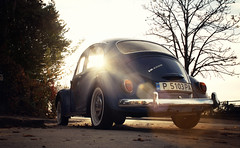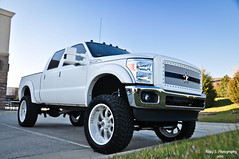
Posted on 06 October 2011 by SACarFan

The new Volkswagen Golf Cabriolet returns to the Golf line after a two (and a half) generation absence, its place in Volkswagen’s line-up taken by the similar-sized Eos.

Built on the same platform as the current Golf 6 hatch, itself inherited from the previous Golf 5, the two-door Cabriolet gets an electro-hydraulic folding roof that can be lowered or raised in 9.5 seconds, at speeds up to 30km/h. As with most convertibles, the windscreen of the Golf Cabriolet takes on a more raked profile, leading to a lower overall roofline. VW claim the Golf Cabriolet to be one of the quietest convertibles on the market, attributable to the new optimised soft top.

Like the Eos and Beetle Cabrio before it, the new Golf Cabrio does away with the centre-mounted rollbar that was a standout feature of previous Golf Cabrio generations, replaced with the same protective pop-up bars featured with the Audi A3 convertible.

The engine line-up includes six turbocharged direct-injection engines, with power outputs ranging from 77 kW to 155 kW. Four of the petrol engines (TSI) and one diesel (TDI) are available with the DSG dual-clutch gearbox; while three of the engines are available with energy-saving BlueMotion Technology. Just how efficiently the new Golf Cabriolet handles fuel is illustrated by the 1.6 TDI BlueMotion that sips just 4.4 L/100 km.

The new VW Golf Cabriolet is scheduled to arrive in South Africa during the first half of 2012. The question is, how will the topless Golf and Eos play together in their small South African market?

Posted on 24 February 2011 by Scott Hayes

The 2011 Geneva Motor Show will mark the return of the Cabriolet nameplate to the Golf range after an almost decade-long hiatus. Based on the underpinnings of the latest generation Golf hatchback, the two-door four-seater features a soft top with an electro-hydraulic drive that can be raised or lowered in only 9.5 seconds. The process can also be performed during driving at speeds of up to 30 km/h.
The exterior styling is similar to the three-door Golf Mk6, which is sold in European markets, with the Cabriolet featuring a unique rear section, lower profile roof line and more swept-back angle of its front windscreen frame. Whereas previous Golf Cabriolets featured a fixed central rollbar, VW’s newcomer gets a pop-up rollover protection system similar to the one found on its sister Audi model, the A3 Convertible. Minus the four-seat layout, the Cabriolet’s interior is identical to that of the hatchback.

The Golf Cabriolet measures 4 215 mm in length, 1 424 mm in height and 1 779 mm in width, meaning its 208 mm shorter than the Eos hardtop convertible. However, the two models share a 2 578 mm wheelbase, resulting in the same interior space for all four passengers. According to Volkswagen, with the roof down, the Cabriolet offers 250-litres of boot space.
In Europe, the convertible version of the Golf will be available with a choice of six turbocharged direct-injection engines whose power outputs range from 77 kW to 155 kW. These include four petrols (1.2-litre TSI 77 kW, 1.4-litre TSI 90 kW, 1.4-liter TSI 120 kW and 2.0-liter TSI 155 kW), and two diesels (1.6-liter TDI 77 kW and 2.0-liter TDI 105 kW). The most fuel efficient version is the 1.6 TDI with 77 kW and BlueMotion Technology, which consumes 4.4 L/100 km and emits 117 g/km of CO2.
In Germany, the order books open today with prices starting at €23.625. There’s been no word from Volkswagen South Africa on whether the new Golf Cabriolet will be offered locally.

Posted on 06 November 2010 by Scott Hayes

Volkswagen has this week announced that its convertible Golf Cabriolet will return in 2011, at the same time signalling the death knell for the Golf 5-based Eos convertible.
The news follows reports from around this time last year that suggested Volkswagen’s purchase of the Karmann brand and its plant at Osnabruck could lead to the Cabrio’s return.
The Golf Cabrio last appeared in the company’s line-up as part of the Golf 3 range, although it benefited from a front-end Golf 4 update in 1999. The Eos, replacing the Cabrio when the fifth-generation Golf arrived, had a similar styling update last month, getting Volkswagen’s new letterbox grille and sharpened headlights.

Volkswagen has offered few details for the new Golf Cabriolet, although it is expected to do away with the folding hardtop of the Eos, returning to the softtop style of its predecessors. As with previous generations, the new Golf Cabrio will likely be all-but-identical to the Golf’s two-door bodystyle from the ground up to the belt line and boot lid.
Production is set to begin next year at Volkswagen’s Osnabruck plant in Germany. The last vehicle to be produced by Karmann at Osnabruck was the Mercedes Benz CLK, which finished production in June last year. Karmann and Volkswagen have a strong history together, thanks in particular to the iconic Beetle-based Karmann Ghia of the 1950s. Previous generations of the Golf Cabriolet have been built by Karmann, and with the current generation Eos reaching the end of its life cycle, a new Golf Cabrio has seemed likely for some time.
The renderings (above and top) offer a glimpse at how the new generation Golf Cabriolet might look.

Posted on 25 November 2009 by Scott Hayes
Sometime ago, rumours of a Golf 6 cabriolet surfaced, complete with renderings and an expected launch date of 2010. Of course production of the car still remains a rumour, and an unconfirmed one at that. Now that VW has completed its takeover of the former Karmann factory in Germany – the once iconic coachbuilder and convertible roof specialists who manufactured the classic Beetle-based Karmann Ghia coupe – rumours of the new cabriolet may not be unfounded. And thanks to the skills of a few graphic designers, we’re able to get an idea of what the new car may look like.

Assuming it gets the green light, the Golf 6 Cabrio will compete with such models as the Opel Astra CC and Peugeot 308CC, but unlike so many folding tin-top cabrios, Golf will instead offer a more traditional fabric top – technology shared with its Audi A3 cousin.
Should the roof technology be the same as that of Audi’s, the Golf Cabrio will utilise a multi-layer construction for impressive refinement at high speeds. The mechanism will also be fully automated and will be able to be raised or lowered at speeds of up to 30 km/h – a process that should take less than 10 seconds. Once down, the roof will sit flush with the bodywork behind the rear seats.








































